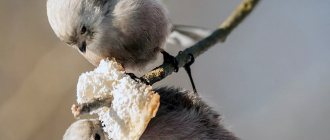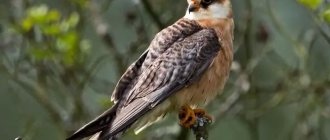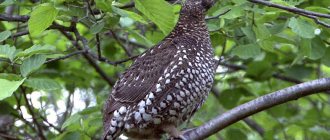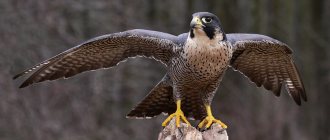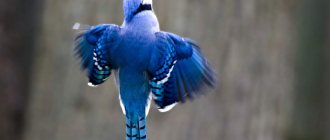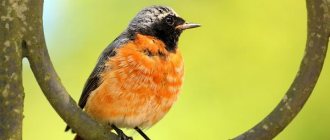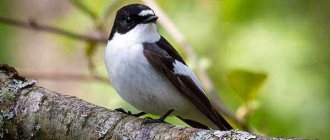- Wild animals
- >>
- Birds
Most representatives of the tit family are known to every person. Small tits live near people and are difficult to confuse with other birds. One of the most unusual tit birds is the tufted tit . Villagers know a lot about it, but in the city these birds are little known to people. Many people don’t even notice such tits among the crowd of other city birds: woodpeckers, jays, crows, sparrows, pigeons. What is so special about tufted tits? Details of the life, appearance, and reproduction of tufted titmice can be found in this publication.
Origin of the species and description
Photo: Tufted Titmouse
The Tufted Tit is a very small bird. It is part of the passerine order, in the tit family. These birds are assigned to a separate genus - “Crested Tits”. In Latin, the name of this species is Lophophanes cristatus. This animal is also called the grenadier. It received this name due to its crest, which looks very much like a grenadier’s hat. Grenadiers lived in the seventeenth and eighteenth centuries. These were elite infantrymen.
Interesting fact: The main habitat of grenadiers is coniferous forests. These tiny birds bring a lot of benefits to the forest. They destroy harmful insects in large numbers, saving trees from certain death.
The main difference between tufted tits and ordinary tits is the presence of a tuft. It is very noticeable, consists of white feathers with transverse streaks of gray. The grenadier, like other tits, is very small. The length of her body rarely exceeds eleven centimeters. In size it can be compared to a blue tit.
Video: Tufted tit
Tufted titmice differ from other tit species not only in their appearance. There are also differences in lifestyle. For example, crested birds are more prone to a sedentary lifestyle. They very rarely migrate, only during severe cold weather or due to lack of food in their habitat. Tits roam along with other species of birds: chickadees, kinglets.
In nature, there are seven types of grenadiers:
- c. cristatus;
- c. abadiei;
- c. mitratus;
- c. scoticus Prazák;
- c. bureschi;
- c. weigoldi;
- c. baschkirikus Snigirewski.
Habitat
The largest population of the tufted tit has spread to the southern Trans-Urals and the entire European region of Russia. Many types of grenadiers are found in the Ukrainian Carpathians. In Europe, the tufted tit can be found in Central Europe and Scandinavia; in the south this bird is extremely rare.
The grenadier prefers coniferous forests as a habitat, but can also settle in mixed forests. They prefer to choose an area without blind spaces.
Appearance and features
Photo: What a tufted tit looks like
The tufted titmouse has characteristic external features:
- small sizes. These birds are much smaller than the great tit. Their body length ranges from eleven to fourteen centimeters. The wingspan is about twenty centimeters. The weight of the animal is no more than eleven grams;
- gray-white crest on the head. This is the most obvious external sign. It is by this that one can distinguish the grenadier from other species of the family. The crest is formed by white and dark gray feathers. In females, as a rule, the crest is smaller and dull in color;
- similar body color in males and females. The top of the bird's body is gray-brown, the bottom is white with small splashes of ocher. Birds have a bright black stripe running from the edge of their eyes to their beaks. The stripe forms a black "crescent". It looks very impressive against the background of a white cheek;
- dark wings, tail, beak. The wingspan is twenty-one centimeters. The beak is small, but quite durable. With its help, birds deftly hunt for harmful insects in the bark of trees;
- small eyes. The iris of the eyes is colored brown. The birds' vision is excellent;
- tenacious paws. The limbs are colored dark gray. There are four toes on each paw. Three of them are directed forward, one is directed backward. This arrangement of fingers helps the corydalis to hold tightly to the branches.
Interesting fact: The crest is not just a striking feature of this species of tit. This is a kind of tool to express their mood. The height of the crest and the angle of inclination depend on the mood.
Types of tits living in Russia
In Central Russia the following types of tit are most often found:
- big (bolshak);
- Moscow;
- blue tit;
- chickadee;
- Apollonovka.
Great tit
The great tit (bolshak) is widespread in Russia. The species “Parus major” is characterized by black coloration of the head and neck, white cheeks, olive color of the plumage of the back, and yellow plumage of the belly. Most often, the great tit lives on forest edges and river banks.
In flight of a great tit, the characteristic shapes of the flight feathers and tail plumage are clearly visible
The size of the Parus major species is comparable to that of a sparrow. In males, the wingspan reaches 26 centimeters, weight varies between 14–21 grams. Females are smaller and are recognized by the dull color of their feathers. This species stands out from the tit family due to its vocal repertoire. Ornithologists have counted many (up to 40) variations of sounds. The male sings more, capable of alternating the rhythm of singing, timbre, and pitch of sounds (up to five options). The length of singing increases during the mating season. Males sing least in late autumn and early winter. This species takes root most poorly in captivity, so the clear voice of the titmouse can rarely be heard in the house.
Moscow tit
The Moscow tit (lesser tit, black tit, moss tit) lives in the coniferous forests of northern and central Russia. The name Muscovite appeared after a change in the original shape of the Muscovy, which the bird received for its characteristic black and white facial mask.
The photo clearly shows the characteristic black and white color of the Muscovy tit.
In terms of body structure, the Muscovite resembles the Bolshak, differing from it in its reduced size and different color. The length of the body does not exceed 11.5 centimeters, weight varies from 7 to 12 grams. 20 subspecies of "Periparus ater" live throughout Eurasia. In addition to Russia, the moss fly is found in the African mountains of Tunisia, Scandinavia (up to the 67th parallel), China, Nepal, the British Isles, and Sicily.
The breeding season for the Periparus ater subspecies lasts from March to June. During this time, monogamous couples manage to make two clutches of eggs. For a cup-shaped nest, pileated woodpecker hollows, rotten stumps, earthen holes, and cracks in rocks are used. The nest is always made by the female, lining the bottom with moss, hair and fur of forest animals, cobwebs and small feathers.
The eggs (white with reddish-brown specks) are incubated by the female for two weeks. The hatched chicks (from 5 to 9) are covered with gray down on the head and back. The female warms the chicks for 3-4 days without flying out to forage. The chicks fly out of the nest after three weeks, but return home to roost for a few more days.
THIS IS INTERESTING. Central Russia is characterized by flocks of 30-40 titmice. But in Siberia, mixed flocks of birds (including pikas, warblers, yellow-headed kinglets) of thousands of individuals have been recorded.
blue tit
The blue tit, which loves warmth, is distributed in Russia below the 58th parallel - its range extends through Bashkiria and the southern spurs of the Urals. In the east, the blue tit is found no further than the South Siberian forest-steppes, the sources of the Irtysh. When looking at a great tit and a blue tit, the differences in coloration are immediately visible.
Color differences between a blue tit and a great tit in a good photograph
The photo of a great tit next to a blue tit shows that the birds differ little in size. The weight of a large blue tit is 5-7 grams less. The main natural habitat of the blue tit is deciduous forests. In Russian regions, the blue tit settles in old birch and oak forests. Ornithologists have deduced the dependence of the population size on the number of old trees in the hollows of which the blue tit nests. The species “Cyanistes caeruleus” does not shy away from people; the blue tit can settle on the outskirts of villages, in forest plantations, gardens, and on river banks overgrown with willow.
Interesting facts about tits include the migration of blue tits. They are characteristic of birds living in the north. Mainland blue tits have irregular migrations, their length does not exceed 30 kilometers. Northern coastal populations are more prone to migration to the south. Thus, Kaliningrad ornithologists noted the flights of the blue tit to the south of Italy (more than 2000 kilometers).
The blue tit exhibits special behavior during the breeding season (April–June). While courting a female, the male dances a mating dance - he hovers in the air in place like a butterfly, soars smoothly, and makes sharp take-offs and dives. Having dropped down, the male crouches to the ground, bends his crest, fluffs out his tail and wings. Singing alternates from cooing, purring to ringing trills.
Couples are monogamous, the marriage union lasts several years. Russian populations are characterized by one oviposition of 7-10 eggs, the male and female blue tits actively defend the nest. At the same time, blue tits imitate the buzzing of wasps and the hissing of snakes. Blue tit chicks do not hatch at the same time; the process lasts for a couple of days. The chicks have no down, they need constant heating by their mother (up to 6 days).
Blue Tit
A separate species of the blue tit genus is the blue tit, which ornithologists observe in southern Siberia. The white blue tit (with the second name “princeling”) is a rare species of a small (sporadic) population.
The blue tit is included in the Russian Red Book and is protected by law
In the photo of the tit, its differences from the common blue tit are clearly visible - the absence of a blue cap (that's why it is called white), and a yellow breast. The characteristic features of the blue tit include:
- blue wings;
- a white transverse stripe in the middle of the wing;
- light border along the blue of the tail;
- dark spot on white chest.
Sometimes the white tit is called the azure or blue tit, but these names are not included in ornithological classifications. For settlement and nesting, the blue tit chooses deciduous forests, poplar groves, bush thickets on river banks, tall grass swamps, and orchards. Willingly settles in damp, marshy areas, among birch, willow, poplar, reed or sedge. Its lifestyle differs little from the common blue tit, but is more secretive during the nesting period.
The blue tit should not be confused with the albino tit. Birds with impaired pigmentation can be found among all species of the tit family, but are not classified as a separate classification.
The genus of chickadees living in Russian territories includes:
- brown-headed tit (puffy tit);
- black-headed chickadee (also known as marsh tit);
- grey-headed chickadee.
Brown-headed Chickadee
In the coniferous forests of Russia, the brown-headed tit is more common, popularly called “puffy” for its feathers fluffed up in the cold and in the rain.
This titmouse is called a chickadee for its fluffy feathers.
The habitat of the brown-headed tit in the east reaches Sakhalin and the Kuril Islands. The southern border passes through northern Ukraine, the Voronezh, Saratov, and Orenburg regions of the Russian Federation. In central Siberia, the chickadee outnumbers all species of the tit family. In Europe, settlement reaches the Southern Alps, Balkans, and Rhodopes.
The chickadee does not like to settle near people; it chooses forest thickets and overgrown river banks. Low-lying hollows in trees and stumps become their favorite nesting places. Often the chickadee itself expands the hollow, plucking out wood fibers.
The species "Parus montanus" includes small, mobile birds inhabiting the forest zones of Europe and Asia. Unlike its close relative, the black-headed chickadee, it gravitates more towards coniferous forests and for this reason is found in northern latitudes. In Siberia, it is less common than other tits in human habitats, preferring continuous taiga, overgrown ravines, and river banks. As a rule, the chickadee prefers a sedentary lifestyle, having adapted to winter even under snowdrifts.
The chickadee has a dense build, a short neck and a large head. The cap, which extends to the back of the head and the top of the back, contrary to its name, is overgrown with matte black feathers. The back, wings, and rump are colored brownish-gray. Pairs of young animals are formed in the first winter and remain until the death of the male or female. Both partners take part in courtship, shaking their wings and arching. Before mating, the male chases the female with a calling song and places food in front of her. The female responds with short calls. The pair's hunting area reaches 9 hectares and is protected from other representatives of the tit family.
The female chickadee does not use moss to form the bottom of the hollow. The bottom for laying eggs is lined with birch bark, pieces of bark, and strips of soaked wood left over from plucking out the hollow. Hatching of chicks from one clutch a year lasts two weeks. Chickadee chicks appear with fluff on their backs and heads, but are helpless for a long time. Chickadee chicks are fed (up to 300 times a day) for three weeks. But even the hatched chicks are not able to feed themselves for another two weeks.
Long-tailed tit
The long-tailed tit, which has spread throughout Russian territory to Kamchatka, does not nest north of the 60th parallel. In local dialects, this species is often called the titmouse Apollonovka or, simplified, the titmouse.
Because of its fluffy body, the long-tailed tit appears from a distance as a ball with a long tail
THIS IS INTERESTING. Due to its characteristic appearance, the Apollonian has become the record holder of the tit family for the number of popular nicknames. It is called grape, blind, chumichka, pheasant, apollovnik, peacock.
Apollonovka settles near people more often than other birds; city residents can observe it in city squares and parks. The Long-tailed Tit is unpredictable in flight. The bird rarely flies in a straight path. In flight, the Apollo aircraft abruptly changes direction, flies along a broken line, descends vertically to the ground, and soars onto branches. Due to its small size (weight no more than 9 grams) and lifestyle, the shape of the nest has also changed. The female Apollonova makes a strong tit nest in the form of a small ball with a side flyer from thin twigs, lichens, and moss. Pairs nest in dense bushes and forks of deciduous trees, preferring coastal areas. The clutch, which is laid twice during the summer, includes up to 12 eggs, which are distinguished by their white color and spots of pink and purple.
Tufted tit
The crested tit (other names “grenadier”, “grenadier”) is most often found in the central regions of Russia, up to Syktyvkar, Arkhangelsk, Karelia. In the east, the border of the grenadier tit's settlement runs along the eastern spurs of the Urals, reaching Yekaterinburg.
The titmouse got its name “grenadier” because of the characteristic shape of its crest.
The small bird received its second name in the 19th century. The reason for the nickname “grenadier” was the crest on her head, reminiscent in shape of a grenadier’s shako. The bird is inconspicuous in color; against the background of forest vegetation, its grayish cheeks, black collar, brown back, and yellowish-white breast stand out little. Grenadiers begin to prepare a place for brood earlier than other species, already in early March or in the thaw of February. The female grenadier uses other people's hollows only in rare cases. Most often, the female, like the brown-headed chickadee, plucks out a hollow in rotten stumps and trunks of old deciduous trees (birch, aspen, alder). In the depths of the nest, the female builds a cup-shaped nest from blades of grass, leaves, and lichens. Cobwebs, moss, squirrel hair, and small feathers are used for bottom litter.
The male marks and guards the nesting territory. For northern populations, one brood of chicks is common, which hatch after incubation by the female (up to two and a half weeks). Parents feed the brood for up to three weeks, feeding the fledged and fledged chicks.
Where does the tufted tit live?
Photo: Tufted tit bird
This species of tit is one of the most widespread throughout European territory. The natural habitat extends from the Iberian Peninsula to the Urals. Tufted titmice live in large numbers in Russia, Scotland, Spain, France and Ukraine. Birds do not live in Italy, Greece, Great Britain, Asia Minor, Scandinavia.
The natural habitat depends on the variety of tufted tit. Yes, R. c. Cristatus inhabit the north and east of Europe, p. c. scoticus Prazák – central and northern Scotland. In western France there are only rivers. c. Abadiei, and r. c. Weigoldi live in the south and west of Iberia. Subspecies r. c. baschkirikus Snigirewski lives in the Urals.
Tufted tits are mostly sedentary birds. The animal rarely changes its place of residence. It shows no interest in long flights. Only occasionally can a bird migrate a short distance. In this case, migration is forced, inherent in northern populations. Corydalis have to leave their homes due to lack of food.
Climatic conditions are very important for grenadiers. They avoid areas that are too hot or too cold. These birds prefer to settle in temperate climate zones. To live, tufted titmice choose coniferous forests, gardens, parks, and beech groves. The selected area must have old, rotten trees. Corydalis are not interested in deciduous plantings. They avoid this type of forest.
Interesting fact: Tufted titmice, native to southern Europe, have a particular preference for tree species. Thickets of Macedonian and sessile oak are very attractive to them. It is in these places that the largest populations of the animal are seen.
Rare species of tits
In city pet stores you can buy rare representatives of the tit family, which are not found in Russia. The yew tit has a bright, decorative appearance .
The bright color of the yew tit combines blue, red, and black tones
The color of the feathers is dominated by gray-blue shades (on the wings, back, tail). The black color of the neck and head contrasts with them. The bird's bright color comes from creamy-yellow spots on its cheeks and forehead and a brownish-red belly. The second name “Japanese” titmouse received from its main distribution area. In Russia, the Red Book species is found only on the islands of the Southern Kuril Islands (Shikotan, Kunashir, Iturup). It tolerates captivity well and eats regular animal and plant foods.
The whiskered tit is also distinguished by its decorative appearance and bright plumage.
In a large photo, it is easy to see the black plumage under the eyes, which gives the name to the whiskered tit
The species “Paradoxornithidae”, which is part of the Sutoraceae family, is widespread in Southeast Asia and is practically not found in Russian territories. This exotic bird lives in reeds and loves warmth. In captivity, it requires special conditions of detention.
the yellow-bellied tit is close to the Russian Muscovy .
Short-tailed, short-billed tit living in China
The main distribution area of the bird, which is exotic for Russians, is western and northern China. Ornithologists have recorded the appearance of several young pairs in the south of the Amur region. Under the guise of Chinese exotica, poultry farmers can offer Russian Muscovy to amateurs. The Chinese species can be distinguished by the less intense coloring of the dark cap and two rows of white spots on the wing plumage.
What does the tufted tit eat?
Photo: Tufted tit, aka grenadier
The diet of corydalis depends on the time of year. In winter, their daily menu is quite meager and monotonous. During the cold season, these birds spend a lot of time in the snow. There they try to find seeds and invertebrates that were blown from the trees by the wind. The diet also includes tree seeds: spruce, pine. If there is not enough food in the habitat, the bird can migrate to nearby areas.
In the summer, the diet is much wider. It includes Lepidoptera, beetles, Homoptera, and spiders. Most often, corydalis eat caterpillars, weevils, leaf beetles and aphids. With this food preference, tufted tits bring great benefits to the forest. Most of the above insects are pests. Less commonly, the diet includes flies, hymenoptera, and other small insects.
A hungry titmouse can spend hours searching for food. She carefully examines every tree in the forest and examines the ground for suitable food. Every little thing falls under her gaze: twigs, cracks in the bark, crevices. After all, it is in such places that you can find caterpillars, insect eggs, and other delicacies. The corydalis looks for larger prey from the air. She can almost instantly “slow down” in the air upon noticing something edible on a tree or ground. Despite its small size, the tufted tit is an excellent hunter!
Nutrition
The basis of the diet of tufted tits consists of various insects. In particular, their favorite food is caterpillars that inhabit the trunks of coniferous trees. In addition to caterpillars, grenadiers can eat invertebrates such as butterflies, spiders, leaf beetles, wasps, bees, weevils, mosquitoes and flies. From autumn to winter, they eat seeds and berries, such as fir, rowan, spruce, juniper and dogwood. In the spring season, you don’t mind enjoying the sap of birch or maple.
Features of character and lifestyle
Photo: Tufted Titmouse
The grenadier is a very rare bird for any settlement. These animals try to stay away from people, preferring to live in the forest. However, nowadays you can increasingly see tufted titmice in the countryside and even in city parks. They team up with other birds, most often representatives of tits. The grenadiers sing quite quietly. Their chirping can be heard in early spring.
As already mentioned, the tufted tit is an inhabitant of coniferous plantations. It avoids completely deciduous forests. For life, the animal chooses spruce and pine forests of middle age. Less often it chooses young trees for nesting. Small populations may occur in mixed forests. Grenadiers avoid too close contact with people. They prefer to spend their lives in the wild, only occasionally appearing in villages, city parks, and public gardens.
Tufted titmice are very active animals. They can't sit still. Every day these birds inspect the forest for food. They not only eat their prey, but also put it in the nest as a reserve. Corydalis stock up on food all year round. This helps them survive in the winter when insects are not found. Grenadier houses are built in old stumps and trees. They choose natural cavities. Sometimes abandoned nests are occupied by crows and squirrels. Their houses are placed within three meters from the ground.
Interesting fact: It is known that many birds change their plumage due to changes in climate, weather conditions, and seasons. Tufted tits retain their usual color throughout the year.
The grenadier is a flocking bird. She easily gets along in the same flock with kinglets, pikas, poison dart frogs, and woodpeckers. Thanks to woodpeckers, such flocks of tiny birds have a high survival rate. Among the birds of your flock, the corydalis can be recognized not only by its characteristic external features, but also by its burring sound.
Winter problems
All tits feel the worst in winter. And at this time they are not particularly picky - they eat what they come across. Of course, as long as the temperature is not too low, the same tufted tit will look for wintering insects, but as soon as it drops to minus 15, it will agree to other food. People who want to help the winged ones in the cold should know that, in addition to trivial grains, they can be given to their wards to support them, but not to poison them. The best feeding would be unsalted lard, raw sunflower, watermelon and pumpkin seeds. If you bought a coconut for the New Year, its shells will become a gift for tits - you just need to hang them on a rope. Please note that tits do not eat bread or traditional millet, so you will feed sparrows and pigeons with them. Sometimes, if there is nothing else, you can offer your tits lean meat or raw bones.
For tits in the cold season, when snow falls and frost hits, it is necessary to build feeders.
These cheerful representatives of the fauna often and with pleasure visit them, sometimes even eating food from human hands. Building a bird feeder is quite simple. You need to cut a hole in the side of an empty five-liter plastic bottle of purified water that is wide enough. We pour tit food at the bottom of the feeder (see above what it can and can’t eat), and tie the structure by the neck to a tree branch growing perpendicular to the ground, at a height of one and a half to two meters. The impromptu table for tits is ready!
Nimble birds also look between the window frames, into the window, where quite often people (especially the elderly) store food in the winter: cottage cheese, butter, lard, sausage. And they feast with great pleasure!
Social structure and reproduction
Photo: Tufted tit or grenadier
The mating season for this species of birds begins in the spring. At the end of March, corydalis look for a mate and begin to build nests. Animals nest in solitary pairs. Males sing very often and loudly during the mating season. It takes grenadiers about eleven days to build a nest. Sometimes it is possible to build a nest faster - in one week. Some pairs settle in ready-made abandoned nests of other birds.
Corydalis nests are placed in the cavities of trees, rotten stumps with a narrow entrance hole. Typically, “houses” are built low - at a distance of no more than three meters from the ground. However, nests of corydalis have been found in nature, located both on the ground and at greater distances from the ground. To build a nest, the tit uses different materials: lichen, wool, hair, plant fluff, cobwebs, insect cocoons. About ten days after the nest is built, the female begins to lay eggs. In one year, birds of this species can have two broods.
Interesting fact: Corydalis lay eggs earlier than other types of tits. They appear in nests already in the first half of April.
At one time, the female corydalis lays about nine eggs. The eggs are small, have a shiny shell, white color with reddish and purple spots. The weight of the eggs does not exceed 1.3 grams, and the length is only sixteen millimeters. After the eggs hatch, the female remains in the nest. She incubates future offspring for fifteen days. At this time, her couple is engaged in foraging. The male not only eats himself, but also feeds the female. After two weeks, the chicks are born. They are born completely helpless, so at first they are looked after by their parents.
Natural enemies of tufted tits
Photo: What a tufted tit looks like
The grenadier is a very small bird. She is practically unable to defend herself in the wild. For this reason, such animals gather in packs. This way they have a better chance of surviving. In order not to become a victim of a predator, the tufted tit needs to be extremely attentive and, at the slightest danger, hide in narrow crevices located in the trees. Natural abilities help corydalis protect themselves from certain death. They fly quite quickly and maneuverably.
Natural enemies of tufted tits include:
- birds of prey. Almost all birds of prey are dangerous. Crows, eagle owls, and owls will never refuse to dine on a grenadier. Predators attack small birds in the air. They deftly capture their prey with their tenacious paws;
- cats. Crested cats are hunted by wild cats, but sometimes they also become prey for ordinary domestic cats. Domestic cats attack birds that accidentally get lost in the park, in the courtyard of a private house;
- martens, foxes. These animals catch small birds on the ground when they are searching for grain food;
- woodpeckers, squirrels. Grenadiers compete with these animals for the best hollows in the forest. Woodpeckers and squirrels often destroy the houses of corydalis, sometimes steal their eggs, and kill their offspring.
Interesting facts about tits
Let's tell you a few facts about the tit bird that you didn't know.
- Linguists believe that the original name of the bird was “zinitsa” (due to the characteristic sounds “zin-zin”). Later, the existing word form appeared, by association with the bluish tint of a white breast in the snow.
- Not all tits are members of the tit family. The wren tit or American thymelia belongs to the warbler family. Moreover, both families are included in the order Passeriformes.
- In Eurasia, tit populations are distributed everywhere, with the exception of the Far North and some island archipelagos.
- According to its status, the tit family does not need protection. In Russia, the only species listed in the Red Book are the whiskered and yew tits.
- In nature, the bird is characterized by a diurnal, sedentary lifestyle.
- The average lifespan in natural conditions rarely reaches five years; birds die from frost and lack of food.
- Daily activity is regulated by the length of daylight hours.
- The natural enemies of a small bird in nature are small forest predators - wild cats, weasel, marten. Of the birds, the tit is hunted by the owl and other predators (depending on its habitat).

